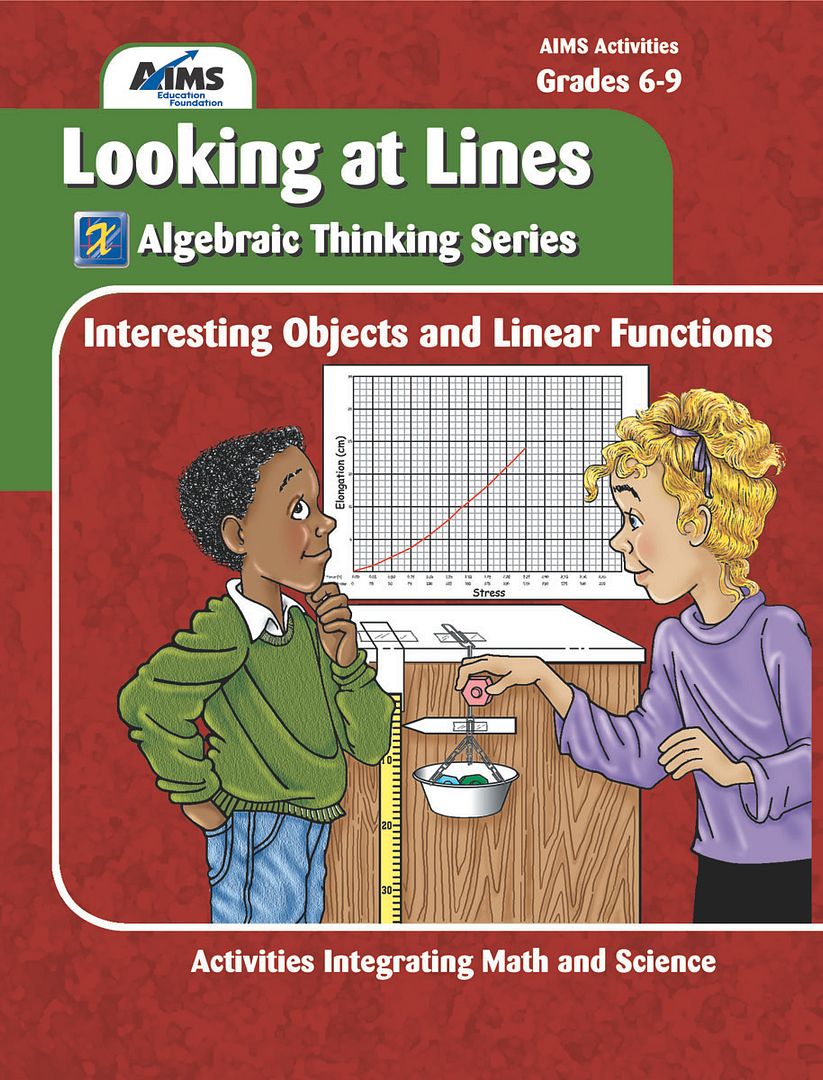A long time ago, in a land far away (Florida) I had a student (Bubba) who did NOT like Algebra. I don't know if it was a remnant leftover from his first few years spent in public school when he felt as if he wasn't "good enough" at math. Or maybe it was too early for him...sometimes kids just aren't ready. Kids' brains develop at different rates, and while some may "get it" early, others may need a few more months or years.
Whatever the reason, we must have tried every available option to get him through Algebra, from a computer program to a tutor and a co-op class, from two different written curricula and a series video lessons to sitting with him for hours as he worked through his "homework" every day. Nothing worked. At least, nothing worked until he was ready.
After a year and a half of beating our heads against the wall, we finally wised up and took a break from math for a while. We moved, and co-operatively decided that he would finish up the last few chapters of the book he'd had the most success with, and with my dad's help (we were temporarily living with my folks while we looked for a house shortly after I'd had Firefly) he completed Algebra STILL hating math. But at least we could check off that box, and fill in the grade report, right?
To be honest, filling in a grade report, with good grades or bad ones, is not really our personal goal for the homeschooling of our children. I am much more concerned with whether they A) have the good character and know-how to begin a project and stick with it until completing it, always giving it their best and B) whether they love to learn and will be lifelong learners, seeking out new things to know, more books to read, and interesting paths, under the guidance of the Lord.
In my book, our Algebra experience with Bubba failed miserably on most of those fronts. He definitely did NOT love to learn any type of math at that point (especially Algebra), we had tried so many venues to achieve the completion of a (meaning ANY) algebra program that I felt we hadn't stuck to much of anything, and his character did not make any gains during the study of algebra, as we had many horrible conflicts over the work or why it was necessary (certain publishers are not very concerned with you knowing why the particulars of the math they teach are important to your "real" life).
In any case, the next year we had a God-inspired moment when we discovered Bob Jones' Consumer Math course. Bubba took to that one like a duck to water. It made sense. At long last, here was a math course that actually seemed to have a real-life use that he saw as valuable to himself (he already had his own lawn care and gardening business at that point). Many of the problems were word problems or used pictorals of some sort to make the abstract ideas concrete. In hindsight, he was probably a good candidate for one of those math programs that used many manipulatives to make the concepts mroe real, but I didn't really know about them at the time.
You may be wondering why I am telling you all of this. My story really does have a point.(smile)
What I want you to get out of this is two-fold. First, I really, really want you to consider that if you have a student who is struggling with math, especially in one of those pivotal areas such as Algebra, PLEASE consider giving them a break and allowing their brain to catch up to your expectations. Taking time off doing something else for a while is not a crazy idea...it does not mean you are neglecting your child's education, and it does not put your child at a disadvantage later. Actually, they will gain many things from taking time off, such as time for their brain to mature, less frustration (and fewer conflicts in your home), and also a trust in you that you put them above some academic expectation that is not as important as they are.
The second thing I want to leave you with is that while trying a different Algebra curriculum or a tutor really wasn't a bad idea (in our case, there were definite problems with why the computer curriculum was a bad fit, so quitting it was the right thing to do), I am going to suggest that you consider trying something a bit different from the traditional second-options (like tutors and a new math book), but that makes complete sense. Something I just didn't even ever think of at the time, but that I am sure would have worked well with Bubba. What I suggest is that you find some other math-type activities that your child will be able to work with...math manipulatives, logic puzzles, mind-benders, a math book based on carpentry or business that uses real-life word problems...basically, anything with visual aids that will help him or her SEE the concepts that they need to understand.
You just can't minimize the importance of attaching a visualization to an abstract concept. The process of showing (vs telling) someone how math works is invaluable. Have you ever seen episodes of the show NUMB3RS? They used math to solve crimes, and the mathematician character, Charlie, was so incredible because he could take these incredibly complex and abstract ideas and turn them into practical examples that even the "average" TV FBI agent (and I) could understand. I admire people who can make math simple, even when a concept is a tough one. I just miss out on being able to do that. I can break math down into steps, I can tell you the rules and the most efficient way to solve the problem, but I can't make it REAL to you, nor can I make you SEE what is really happening in the "mathosphere." It's a gift I apparently do not have.
Well, in case I am not alone in being deficient in this sort of math genius, I am going to happily tell you that there is someone out there who does have that genius, and they are smart enough to hire lots of those math geniuses to write some pretty useful books to help our students visual the reality and practicality of math...The Critical Thinking Company.
I honestly should have known that they could explain math in such a useful way because I have successfully used their products in our homeschool before...just not the math ones. We have used their Editor-in-Chief and their Mind Benders products before with much enjoyment. The Editor-in-Chief series offers students practical ways to apply the learning of grammar, spelling, punctuation, and mechanics rules by having them edit a variety of stories, knowing only how many errors are in the selection...kind of like a treasure hunt...and my son, Tex, loves doing them. Why? Because they are more practical and interesting than completing endless exercises in a grammar or spelling book, and because they challenge him to be attentive and to "beat" the puzzle (and he likes puzzles).
I am so glad we were chosen to review Balance Math, a line of math exercises from Critical Thinking Company created to develop students' understanding of algebraic equations using the visual representation of equations. Tex has been working his way through Khan Academy's free math program this year, focusing on developing his Algebra skills, and he loved both of these books the moment we opened up their packages...he found them to be a welcome change from his online work, and felt they were more fun than work. Now that's a big plus!!
The problems vary from balancing equations using that scale visual to sudoku-type problems, and all work is meant to strengthen the student's ability to see the conceptual understanding and algebraic reasoning. It did not take long for him to work his way thorough the book, which costs $9.99 for 48 pages of exercises and their answers, which might seem a bit much for a "puzzle book" BUT the reward was great---enthusiasm for the subject. Priceless. The only criticism I have ever heard of about Critical Thinking Company is that their prices are a bit steep for certain products, but since they are providing such a valuable and quality service---helping kids learn to think critically and logically---the extra cost is worth it.
Once we recieved Balance Math Teaches Algebra, Tex started going through it with his dad. Hubby, who is a science and math geek, felt that the book was very effective in how it used pictures to demonstrate the algebraic equations, rules, and concepts. The first section of the exercise book graphically demonstrate the basic rules of balancing equations (through step by step problems), then the subsequent pages move in a logical sequence from the simple to more complex problems. He felt this book would be best used on a 1-2 exercises per week basis for a few months, but acknowledges that it would also be a good substitution for a regular curriculum if you have a student who is stuck in a rut and needs help out (or a creative learner, such as an unschooler or a younger student who wants to learn ahead of "schedule"), or as a gradual and intriguing introduction before jumping into the meatier concepts in most Algebra curricula. The book is a total of 62 pages (answers included) and costs $14.99.
The only drawback to these books is that if you, the teacher, do not understand the concepts yourself, you will need to get your own copy and work through it before offering it to your student (or you will have to hope that someone else in your family "gets" Algebra, so they can help if your student gets stuck.) There is no teachers manual, and the answers are just answers, not explanations.
I think that Tex's simple words of the other day, "Mom, I really love this book. Can we get more?" say it all. If you can find that something that incites your student to pursue knowlede and love learning, to be challenged and eager, then why would you say, "No?"
If you have students who need a bit of something to get them back on track with math, check out some of these other math products from Critical Thinking Company.
Check out what others on the Crew said about the Critical Thinking Company products they tried at the TOS Homeschool Review Crew blog.
Blessing,
Disclaimer: I received copies of Balance Math Teaches Algebra! and Balance Math & More Level 2 for the purposes of reviewing the product. I recieved no other compensation, and the opinions you see in my review are my own, based upon our families' experiences with this product.
























